|

Summer 2002 (10.2)
Pages
26-27
Voices of the Ancients
Heyerdahl
Intrigued by Rare Caucasus Albanian Text
by Dr. Zaza Aleksidze
Also
spelled Zaza Alexidze
 
Other articles
related to Thor Heyerdahl:
(1) Thor Heyerdahl in Azerbaijan: KON-TIKI
Man
by Betty Blair (AI 3:1, Spring 1995)
(2) The Azerbaijan Connection: Challenging
Euro-Centric Theories of Migration by Heyerdahl (AI 3:1, Spring 1995)
(3) Azerbaijan's
Primal Music Norwegians Find 'The Land We Come From' by Steinar Opheim (AI
5.4, Winter 1997)
(4) Thor
Heyerdahl in Baku
(AI 7:3, Autumn 1999)
(5) Scandinavian
Ancestry: Tracing Roots to Azerbaijan - Thor Heyerdahl (AI 8.2, Summer 2000)
(6) Quote:
Earlier Civilizations - More Advanced - Thor Heyerdahl (AI 8.3, Autumn 2000)
(7) The
Kish Church - Digging Up History - An Interview with J. Bjornar Storfjel
(AI 8.4, Winter 2000)
(8) Adventurer's
Death Touches Russia's Soul - Constantine Pleshakov (AI 10.2,
Summer 2002)
(9) Reflections on Life
- Thor Heyerdahl (AI 10.2, Summer 2002)
(10) First Encounters in
the Soviet Union - Thor Heyerdahl (AI 10.2, Summer 2002)
(11) Thor Heyerdahl's
Final Projects - Bjornar Storfjell (AI 10.2, Summer 2002)
(12) Heyerdahl
Burns "Tigris" Reed Ship to Protest War - Letter
to UN - Bjornar Storfjell, Blair - (AI 11.1Winter 2003)
Articles related to Zaza Aleksidze and
the Caucasian Albanian Script
1 Udi
Language: Compared with Ancient Albanian - Aleksidze
2 Quick
Facts: Caucasian Albanian Script - Aleksidze and Blair
3 Albanian
Script: How Its Secrets Were Revealed? - Aleksidze and Blair
4 Zaza
Aleksidze. Decipherer: Glimpses of Childhood - Blair
5 Caucasian
Albanian Script: Significance of Dechipherment - Aleksidze
6 Udins
Today: Ancestors of the Caucasian Albanians - Zurab Konanchev
7 Heyerdahl Intrigued
by Rare Caucasus Albanian Text
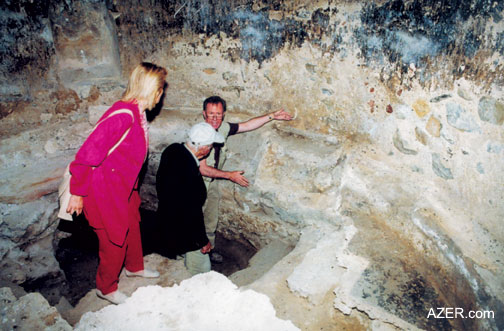
_____
Much of the territory of modern
Azerbaijan was once known as Caucasus Albania - not to be confused
with the modern country of Albania found in the Balkans. Caucasus
Albania remained a cohesive, mostly Christian, political entity
in the area from the third to eighth centuries A.D. But even
though the ancient Albanians were highly advanced and had their
own writing system, very few remnants are left from their civilization.
A few Albanian inscriptions were found in Azerbaijan in 1948-49
during an archeological excavation, but until recently, no one
could figure out how to decipher them.
According to Professor Zaza Alexidze, one of the world's top
experts on the Caucasus Albanian period, some amazing progress
has been made on this front in the past few years. His remarkable
discovery of a rare Albanian church service book even attracted
the attention of the late Thor Heyerdahl, who was very interested
in the possibility that the ancient Caucasus Albania region was
the original home of the Scandinavian ancestor Odin. Heyerdahl,
unlike many other scholars, took Odin to be a real person who
migrated to the region from the Azerbaijan region, not just a
mythological character.
______
Dr. Thor Heyerdahl was a legendary personality for the teenagers
of my generation living in Georgia. We were fascinated by his
books and films. I'm sure that for many of us, his example influenced
our career choices and academic directions. As for me, I decided
to specialize in the study of ancient texts. Today I am the Director
of the Institute of Manuscripts in Tbilisi, Georgia.
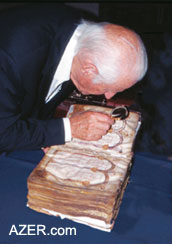  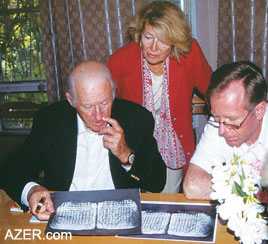
Left: Thor Heyerdahl examines a text at the
Institute of Manuscripts in Tbilisi, Georgia, during his September
2000 visit.
Right: Thor Heyerdahl, Thor's wife Jacqueline,
and archeologist Bjornar Storfjell examine copies of the ancient
Caucasus Albanian church service book at the Institute of Manuscripts
in Tbilisi, Georgia.
So you can imagine my joy when I heard that Thor Heyerdahl wanted
to pay a visit to the Institute of Manuscripts to see me. His
visit was one of the most interesting and important days of my
life.
Heyerdahl was convinced that the Scandinavian god Odin was actually
a historical figure who had originated from the Caucasus and
then migrated with large numbers of his people to Scandinavia.
Heyerdahl's search for the traces of Odin had taken him to Azerbaijan
to find out more about the Udis, a small Christian minority living
there.
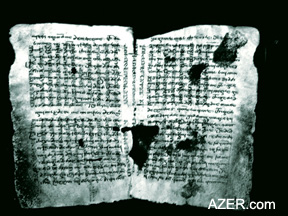  The Udis' ancestry and language dates
back to the highly developed Caucasus Albanian population that
used to live throughout the region prior to the 10th century.
After that time, the Caucasus Albanian state, people and culture
gradually vanished from the historical arena. Today the few thousand
remaining Udis live in three villages: Nij and Oghuz (previously
Vartashen) in Azerbaijan and Zinobiani in Georgia. The Udis' ancestry and language dates
back to the highly developed Caucasus Albanian population that
used to live throughout the region prior to the 10th century.
After that time, the Caucasus Albanian state, people and culture
gradually vanished from the historical arena. Today the few thousand
remaining Udis live in three villages: Nij and Oghuz (previously
Vartashen) in Azerbaijan and Zinobiani in Georgia.
Important Discovery
Some scholars believed that the Caucasus Albanians in this area
never had their own written language and alphabet. All known
Albanian texts had been preserved only in the Armenian language.
But in 1996, I discovered an ancient manuscript that proved conclusively
that Caucasus Albania once had its own highly developed written
language. During an expedition to St. Catherine's monastery on
Mt. Sinai in Egypt, I found a unique palimpsest, a type of parchment
manuscript that has two layers of text. The top layer of text
was Georgian, but beneath it was another layer - this one, written
in Albanian script.
Back in the Early Middle Ages, parchment was very expensive and
in great demand, so it was typical for manuscripts to be reused.
In this particular manuscript, the lower Albanian text was washed
away so that the 10th-century Georgian text could be written
on top of it. That makes the lower-layered Albanian text very
difficult and time consuming to read, but with the help of modern
technology and special illumination, we can determine what it
says.
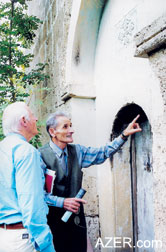  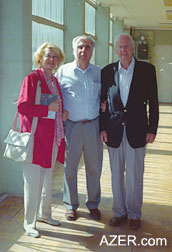  When Heyerdahl visited me in Tbilisi
in September 2000, he was very curious to learn more about my
discovery. I showed him several photos of the palimpsest and
some of the pages that I had copied from it. When Heyerdahl visited me in Tbilisi
in September 2000, he was very curious to learn more about my
discovery. I showed him several photos of the palimpsest and
some of the pages that I had copied from it.
We had a long talk, exchanged views and spoke about future joint
plans. He also visited the repository of the Institute of Manuscripts,
which contains a large number of ancient manuscripts and historical
documents in Georgian and many other languages.
My work of deciphering the lower layer of the Georgian-Albanian
palimpsest continued until the beginning of 2001. Unfortunately,
I never had another chance to see Heyerdahl, and I'm not sure
if he heard about the preliminary results of my work. My upcoming
book, which documents the results of deciphering the Albanian
manuscript, will be dedicated to Dr. Thor Heyerdahl's sacred
memory.
Ancient Lectionary
The palimpsest, as it turns out, is from a Christian Albanian
lectionary, a church service book that contained a collection
of liturgical lessons that were read throughout the church year
and mainly consisted of readings from the Old and New Testaments.
To compile a lectionary, one must first have a translation of
the Bible available in that language.
This Albanian lectionary is very simplified, with only readings
for 12 religious feasts along with some psalms and praises (alleluias).
Unlike other ancient lectionaries, there is no evidence of a
calendar system, no mention of any saints or ecclesiastical Fathers
and nothing about liturgical processions to the holy places in
Jerusalem and stops at relevant churches.
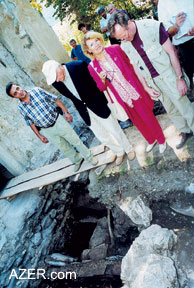  Traditionally within the church, lectionaries
have evolved from being very simple to more and more complex.
This means that in all probability, the Albanian text represents
one of the first lectionaries ever written. It may even date
back to the second half of the 4th century. In turn, that would
mean that the written Albanian language had been created even
earlier. Traditionally within the church, lectionaries
have evolved from being very simple to more and more complex.
This means that in all probability, the Albanian text represents
one of the first lectionaries ever written. It may even date
back to the second half of the 4th century. In turn, that would
mean that the written Albanian language had been created even
earlier.
It's also interesting to note that some of the lessons given
in the Albanian lectionary are not found in ancient Armenian
and Georgian lectionaries. This may indicate that the Albanian
lectionary was not translated from those other languages but
was composed independently based on a Greek lectionary, which
no longer exists.
Lost for Centuries
So why did the Albanian script disappear in the first place?
In the 8th to 10th centuries, Arab invaders and Armenian clerics
burned documents that were written in the Albanian language.
The Albanian Church until around 720 AD was Diophysite, meaning
that it perceived Christ as having a dual nature - both human
and divine. The Armenian Church, however, was Monophysite and
believed that Christ's nature was altogether divine. It wanted
to stamp out any literature that was considered to be Diophysite.
From about 720 onwards, the Albanian church was strongly affected
by the influence of the Monophysite Armenian Church. Albania
gradually adopted the Armenian language and script, and thus,
step by step, lost its national identity and written language.
Up until recently, the only Albanian historical and ecclesiastical
texts we had access to were translations that had been preserved
in the Armenian language.
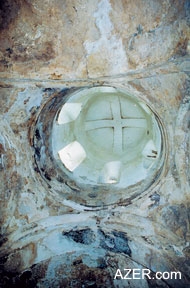  By examining the language found in the
palimpsest, I discovered that the direct descendants of the Albanian
people, the Udis, still speak a language that is very similar
to the ancient Albanian language. Up until recently, the Udis
wrote their language in the Cyrillic alphabet; now that Azerbaijan
has opted for a Latin-based script, they, too, have switched
to the Latin alphabet. But neither alphabet can handle the 50
or more phonemes found in the Udi language without creation of
additional symbols. [As of this writing, the work on the Udi
grammar has not yet been finished. Some scholars identify 52
letters, some 54, others 48]. Perhaps this new discovery will
mean that the Udis can reclaim their long-forgotten alphabet
once again. By examining the language found in the
palimpsest, I discovered that the direct descendants of the Albanian
people, the Udis, still speak a language that is very similar
to the ancient Albanian language. Up until recently, the Udis
wrote their language in the Cyrillic alphabet; now that Azerbaijan
has opted for a Latin-based script, they, too, have switched
to the Latin alphabet. But neither alphabet can handle the 50
or more phonemes found in the Udi language without creation of
additional symbols. [As of this writing, the work on the Udi
grammar has not yet been finished. Some scholars identify 52
letters, some 54, others 48]. Perhaps this new discovery will
mean that the Udis can reclaim their long-forgotten alphabet
once again.
Unto the Unknown
Now there is no doubt that the Caucasus Albanians once had their
own written language and literature. But many questions remain:
When was the Caucasus Albanian state formed on this territory?
How far did it spread? How did the process of ethnic and cultural
consolidation develop there?
Up until recently, the only information we had about the Albanian
language came from Armenian sources. But now, this discovery
will enable us to have access to less biased sources about the
history of Albania, which may even reshape our ideas about ethnic
origins and the history of the Albanian nation. An unknown civilization
is revealing itself to us through its ancient alphabet.
Dr. Zaza Alexidze is the Director of the K. Kekelidze Institute
of Manuscripts of the Georgian Academy of Science (1989-) and
Head of the Armenology Department at Tbilisi State University
(1979-). Contact: Dr. M. Alexidze, Institute of Manuscripts,
Street 1, Bild 3, Tbilisi 380003, Georgia. Tel/Fax: (995-32)
94-25-18.
Email: zaza_alexidze@hotmail.com.
______
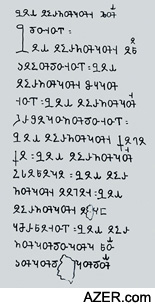  Right: A page of the Caucasus Albanian-Georgian
palimpsest discovered by the author at Mt. Sinai. In the 10th
century, the Caucasus Albanian writing was partially washed away
from the parchment, and then a Georgian text was written perpendicular
to it. Right: A page of the Caucasus Albanian-Georgian
palimpsest discovered by the author at Mt. Sinai. In the 10th
century, the Caucasus Albanian writing was partially washed away
from the parchment, and then a Georgian text was written perpendicular
to it.
From the Caucasian Albanian
text found in one of the palimpsests at the Mt. Sinai monastery
(Egypt). This segment was identified by Dr. Zaza Alexidze, as
II Corinthians 11:26-27 in which the Apostle Paul provides a
short autobiographical summary of what he has suffered to proclaim
about Christ. The Living Bible Translation reads:
(26) "I have traveled many weary miles and have often been
in great danger from flooded rivers, and from robbers, and from
my own people, the Jews, as well as from the hands of the Gentiles.
I have faced grave danger from mobs in the cities, and from death
in the deserts, and on the stormy seas, and from men who claim
to be brothers in Christ, but who are not.
(27) I have lived with weariness and pain and sleepless nights.
I've often been hungry and thirsty and have gone without food;
often I have shivered in the cold, without enough clothing to
keep me warm."
To see Detailed Notes on the
Grammar of this Biblical passage (II Corinthians 11:26-27) in
Caucasian Albanian text by Dr. Zaza Alexidze, visit: www.lrz-muenchen.de/%7Ewschulze/Cauc_alb.htm#gram.
To see: "A Functional Grammar of Udi" by German Professor
Dr. Wolfgang Schulze of the University of Munich, visit: www.lrz-muenchen.de/~wschulze/FGU.htm.
____
Back to Index
AI 10.2 (Summer 2002)
AI Home
| Magazine
Choice
| Topics
| AI Store | Contact us
Other Web sites
created by Azerbaijan International
AZgallery.org | AZERI.org | HAJIBEYOV.com
|










